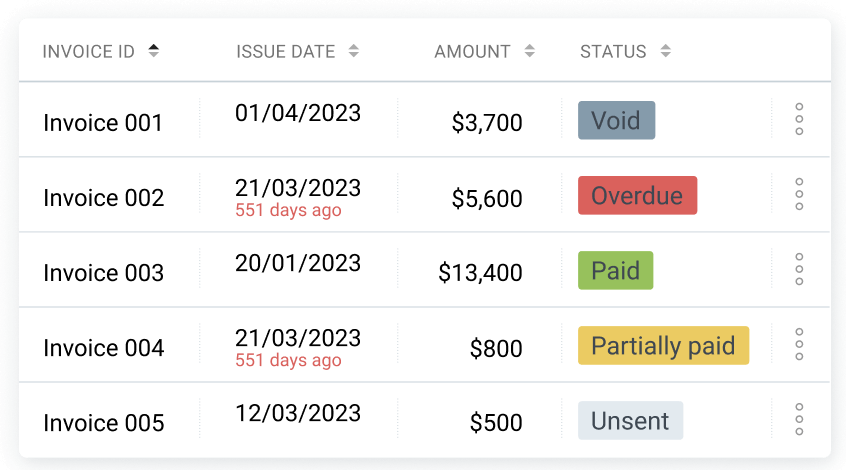Billing per project is complex, as it involves creating pricing, timelines, and invoicing clients for every project and service you offer. So, learning how to do it properly ensures you avoid any invoicing errors and get paid for your work properly.
For that reason, we’ve created this definitive guide to project billing. We’ll answer pressing billing and invoicing questions, such as:
- What is project billing,
- What are the main types of billing,
- How to charge for work, and
- How to ensure you get paid for your services.

- Project billing is the process of setting prices, invoicing, and getting paid for your work.
- When charging for their services, most people choose either charging a flat fee or billing for time and materials.
- Proper timeline and cost estimation are key aspects of project billing.
- Good communication with a client is essential for getting paid for your work.
- Accounting software speeds up the process of billing and invoicing.
Table of Contents
What is project billing?
Project billing is the complete process of creating prices, invoicing, and getting paid for a project you worked on.
In larger companies, this process is often handled by the accounting department, or an accounting specialist hired outside of the company.
Yet, small businesses, contractors, and freelancers often manage billing on their own. This is why it’s essential to know how to properly estimate and account for project expenses to create fair pricing for your services.
Types of project billing
There are two most common types of billing:
- Charging a flat fee, and
- Invoicing for time and materials.
A flat fee is a fixed fee you charge for a professional service. So, you always charge the same for this service, regardless of the number of hours you put into it.
You can charge a flat fee at the beginning or at the end of the project. Alternatively, you can divide the payment into installments and charge clients upon reaching specific milestones.
When charging for time and materials in projects, you bill your client for a specific service based on the number of hours and resources you’ve put into it.
Apart from the already mentioned most common types of billing, some agencies and service providers use subscription billing for longer projects. This billing method is based on a subscription fee that has to be paid in agreed intervals (typically monthly). It requires a longer commitment and a lot of planning, which makes this type much less common than fixed fee and time and materials types of billing methods.
💡Clockify Pro Tip
Unsure how to determine and calculate your hourly rate? Click on this article:
How to charge a flat fee
Charging a flat fee involves creating a fixed price for your services. No matter if you’re a freelancer, contractor, or a small business, you can follow these steps to estimate your price correctly.
Step #1: Estimate the duration of the project
Estimating project duration includes:
- The time you spend working on the project directly, and
- The time you’ll need to spend on project-related administration and similar tasks (such as commutes, phone calls, and email communication).
Knowing how much time a project takes helps you come up with fair pricing for your services.
💡Clockify Pro Tip
If you’re looking for tips on estimating time for your projects, check out this guide:
Step #2: Define variables
Not all projects are equal, even if they’re officially the same type of project. So, you need to define variables that help you price your projects.
For example, handling the interface design of an application may sound like a one-size-fits-all type of project, but it usually differs in execution and practice. Some projects require a more elaborate design, more features included in the interface, etc.
Moreover, you’re free to charge more to a more demanding client who’s hard to please and requires additional work, as this usually means more time spent on a project. So, make sure all of these specifics are reflected in the flat fee estimate you present to your client.
Also, don’t forget operating costs that aren’t directly related to the project since fixed fee project billing should include a portion of the costs required to run your business. This includes overhead costs such as rent and utilities, administrative fees, and supplies.
💡Clockify Pro Tip
In case you own a web design agency, this guide could help you with pricing your services:
Step #3: Present the billing schedule to the client
When you determine the final cost of your work, you have to discuss the payment schedule with the client and provide clear deadlines for the payments.
You can ask for all of the money upfront, divide the payment into installments, or ask for half of the payment before the project starts and the remaining half after you finish the work.
If you opt for payment in installments, for example, those installments can be divided based on the project timeline or milestones.
However, regardless of the way you divide payments, make sure to have the specifics you agreed on in writing. You should always have clear confirmation from the client that they understand your price and agree to pay it to prevent future billing issues.
How to bill for time and materials
Time and materials project billing is a more flexible project billing type. It allows you to account for the additional time you spend working, and all the effort and resources you put into your work.
💡Clockify Pro Tip
Interested to learn about the optimal average hourly rates for your business? Consult our all-inclusive guide here:
Step #1: Track your billable hours
You need to keep track of the time you spend on a project to know how much you should bill your client.
Tracking billable hours on your own can be time-consuming and harder to track. To automate this process, try a time tracker. A good project billing software, such as Clockify, allows you to:
- Define your hourly rate,
- Manually or automatically track your billable hours,
- Define your project and project-related tasks,
- View your earnings, and
- Generate reports for specific projects and clients.
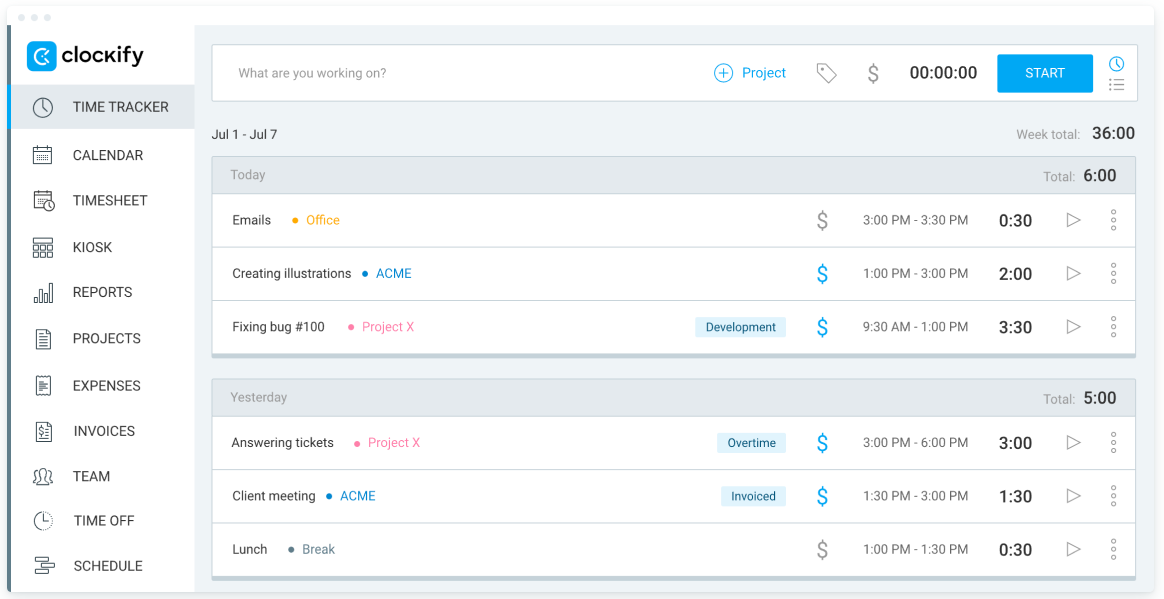
💡Clockify Pro Tip
Are you interested in learning more about tracking billable time? Check out this guide:
Step #2: Add up other expenses
Aside from tracking time on the tasks related to the project, you should also add up all of the other project-related expenses you want to charge the client for.
Project-related expenses include, but aren’t limited to:
- Materials,
- Permits,
- Fees for outside contractors,
- Use of specific software related to the project, and
- Equipment rentals.
💡Clockify Pro Tip
If you want to learn how to easily keep track of project expenses, check out these guides:
Step #3: Present a detailed overview of the work to the client
When billing for time and materials, you have to account for every project-related expense and time worked and present it to the client. To minimize subsequent emails and phone calls by adding additional notes about ambiguous items, make the tasks and descriptions as clear as possible.
If you want to simplify the invoice, you can ask the client if they’re okay with time rounding. Time rounding rounds up the time worked into increments, typically in 15-minute intervals. This makes the list of your tasks easier to follow.
How to invoice clients and ask for payment
Invoicing doesn’t have to be time-consuming if you know the proper way to do it.
So, in this section, you’ll learn:
- How to create an invoice,
- How to encourage clients to pay,
- How to ask a client for more money, and
- How to ask for payment politely.
Invoicing clients
You can make your own invoice, use an invoice template, or find high-quality invoicing software that can do all the work for you.
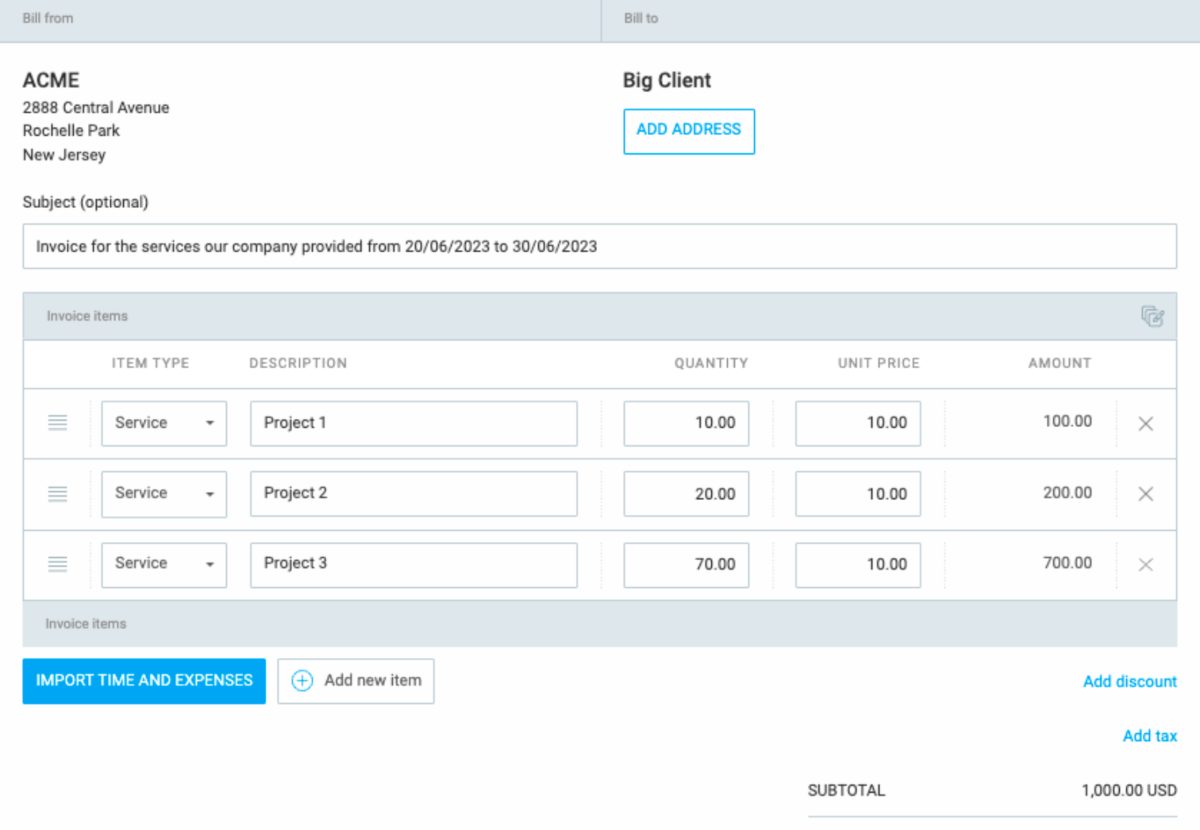
Regardless of the method you opt for, your invoice should include:
- Information about you/your company, including the name, the address, and the phone number,
- Information about the work you performed,
- Pricing,
- Billing information, including the payment method you agreed on, and
- Any additional information, such as return policy and number of installments (if there are any).
To ensure you have records of every project-related activity, track the time you spend on tasks while you’re working on them. Also, save records about every transaction to make sure your business is compliant with your country’s laws and regulations.
💡Clockify Pro Tip
For more information about state labor laws, check out this page:
Automate invoicing with a tool
If you’re looking to speed up the project management invoicing process, you may want to invest in a tool that offers both time tracking and invoicing.
Clockify is a time tracking software that allows you to track the time you spend on projects and tasks, monitor expenses, and create invoices based on the time worked. You can add your and your client’s billing addresses, invoice dates, and detailed invoice items.
For recurring clients, you also have the option to Create clients and save their information. Whenever you need to invoice them for the project, simply click on choose a client from a drop-down menu and their information will be imported into the invoice.
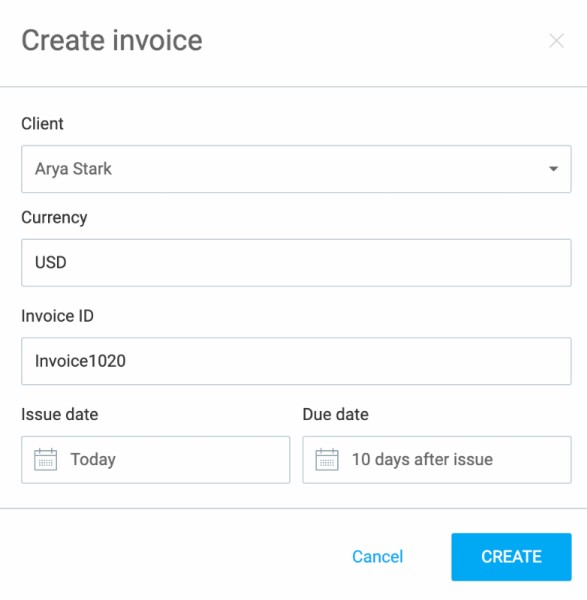
When it comes to invoicing for hours worked, you have two options. The first one is to manually enter the information about the hours you spent on the project and your hourly rates.
Alternatively, you can import both the time you tracked and the expenses you input into your invoice. You can specify the projects and date range for which you’d like to import time and expenses.

Once you choose a specific project and date range, Clockify imports all billable time entries. You don’t have to worry about double-charging for time worked, as any entry that has already been invoiced won’t be imported.
Here’s a detailed guide on how to enable the Invoicing feature, create an invoice, import time tracked, and generate reports based on invoiced items:
💡Clockify Pro Tip
Want to streamline your accounting transactions and learn how to bill clients online? Here are some accounting tools you can try:
Encouraging clients to pay
Although you cannot guarantee your clients will pay for your services, you can minimize these chances of not getting paid by following certain rules on how to bill clients:
- Make payments easy for the client — choose an easy payment method, preferably one your client is familiar with,
- Offer benefits for fair payments — offer discounts for early payment and/or include an extra late fee for people who want to pay after the discussed and agreed upon deadline,
- Request partial up-front payment — up-front payment is proof your client is willing to pay you for the work and helps you cover initial project costs and expenses, and
- Maintain great client relationships — a satisfied client is more likely to pay you on time. When discussing the project send straightforward but friendly emails, and be as accommodating to clients’ requests as possible.
Asking clients for more money
As soon as you realize you need more resources to cover project costs, you should come up with a new budget. You also need to:
- Communicate the changes to the client on time — contact the client in a direct, prompt, and straightforward manner as soon as you realize you’ll need a bigger budget,
- Provide proof of the changes — clarify what items you need more money for, provide specific reasons and proof, and
- Document all changes — create a new budget agreement that includes the new pricing.
Asking clients for payment politely
If you realize all payment deadlines have been breached and you still haven’t been paid, you’ll need to push matters forward yourself.
Here are some invoice late fee-wording tips you can try when you want to ask the client for payment politely:
- Send a firm (but friendly) email asking for payment — be straightforward about payment details (the amount, the payment method, etc.), but friendly,

- Send a follow-up email after two weeks if you receive no response to the first email — be firmer in this follow-up email, but retain a friendly undertone. You can also install an extra fee for your client if they don’t pay you before a certain deadline, and
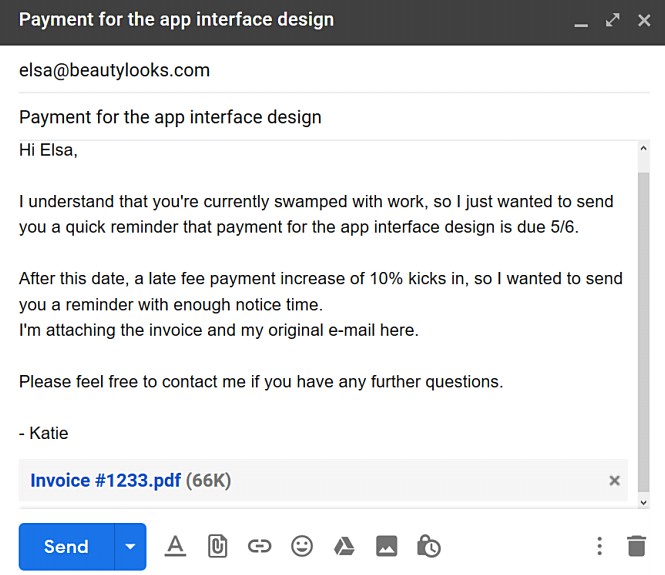
- Make a phone call — if you don’t receive a response, contact the client to remind them of your payment agreement (due date and late fee details included) and make further arrangements for the payment.
What are the challenges of project billing?
Project billing is complex, as it involves creating pricing and explaining your costs for each project separately. Small businesses, contractors, and freelancers all face various challenges in the process of charging for their services.
Here are the most common ones.
Challenge #1: The complexity of billing per project
Billing for your work involves much more than estimating the time you’ll spend on a project and charging for that time. That is why having a separate billing process for every project can be complicated and time-consuming.
But, Finance Specialist Kevin Huffman believes the right system and a good billing tool help automate the billing process and avoid errors:

“Project billing processes could be greatly enhanced using an integrated project management and accounting system. This would allow time and expenses to be tracked ‘on the fly’, so everything is billed accurately in a transparent way.”
Challenge #2: Accounting for unpredictable costs
Unpredictable costs during a project affect both you and your client.
If you’re charging for time and materials, additional expenses or time spent on a project directly affect the final cost of services. In case the final cost exceeds the client’s budget, they may refuse to reimburse you for the additional expenses that occurred.
Inversely, when you’re charging a fixed fee, any additional expenses are on you.
On the upside, by maintaining clear communication and explaining the unpredictable circumstances that occurred to the client, you may be able to agree on a new budget that encompasses the changes.
CEO of VentureSmarter, Jon Morgan, believes thorough project assessment mitigates the issue of unpredictable costs:

“Sometimes, unforeseen obstacles arise, causing delays and increased expenses. To tackle this, it’s essential to invest time in a comprehensive project assessment before providing a quote. Break down the project into tasks, evaluate potential risks, and incorporate buffers for unforeseen circumstances.”
Challenge #3: Charging for operating costs
Operating costs that aren’t directly related to the specific project you’re working on also have to be accounted for. Administrative fees, rent and utilities, training, professional software, and subscriptions are part of your business operations.
If you don’t learn how to properly include them in your service rates, you’ll end up losing money. So, you need to set up a system to distribute the operating expenses across your projects and add them to the cost of your services.
Considering the complexity of billing per project and accounting for operating costs, Huffman suggests performing regular internal audits of the billing processes. This way, you’ll perfect a billing system that accurately predicts your project expenses and accounts for the operating costs.
5 Tips for improved project billing
Looking to perfect the billing process and avoid potential misunderstandings? Check out these 5 tips for improved project billing.
Tip #1: Establish the terms upfront
Every aspect of billing and invoicing should be agreed on with a client before you start working on a project. This ensures both parties have a clear understanding of what’s expected of them regarding deliverables and pricing.
Billing aspects you need to agree on before the project starts include:
- Pricing,
- The type of billing,
- Payment method,
- Timelines,
- The number of installments and their dates (if applicable), and
- Possible penalties for late payments.
Tip #2: Sign an agreement
Signing a contract with a client ensures you have records of everything you agreed on. This provides legal protection in case any issues arise.
Furthermore, a client is more likely to honor their obligations with a written agreement in place, as it presents proof of their commitments.
Tip #3: Set realistic timelines and expectations
Learning how to properly estimate your projects is a key to getting paid.
The inability to deliver what you promised makes you look unprofessional and could cause frustration with the client. This could result in their refusal to pay for your services.
Tip #4: Maintain clear communication
Clear communication goes a long way in ensuring you bill your client and get paid properly.
For starters, make sure the client understands every billing-related aspect of the project.
Then, if you encounter any issues, communicate them with a client immediately. Don’t make any changes to the process and the pricing before getting a client’s approval.
Morgan highlights that proactive communication leads to transparent and fair billing:

“Regularly update clients on the project’s progress, discuss any proposed changes, and agree upon additional costs before implementing them. This proactive approach helps manage expectations and ensures billing remains transparent and fair.”
Tip #5: Consult a legal expert
A legal expert can help you draft a contract to sign with your clients. Moreover, they can help with determining possible penalties for late payments and dispute any issues that may arise.
In addition, they can help you file your taxes, which can be a complicated process for 1099 contractors. Lastly, if you’re working with international clients, you could benefit from legal advice on cross-border billing.
How to bill and invoice projects with Clockify
With our guide, billing and invoicing don’t have to be a stressful process. After choosing the type of billing and agreeing on it with a client, you have to create a fair price for your services and determine the payment method.
A key aspect of billing for projects is invoicing. Use the advice from this guide to learn how to properly invoice clients, encourage them to pay, politely ask for a payment, and what to do if you need more money.
Bear in mind — tracking your hours and tasks for the project and generating detailed invoices make you seem more professional. For an easier time tracking and invoicing, try Clockify. It offers many great features for freelancers such as monitoring project progress, creating earning estimates, and generating reports to send to clients.

This software also gives you an overview of all of the invoices you created. You can mark your invoices as “sent” once you send them to a client, and after you receive the payment, you can mark the invoice as “paid”.
